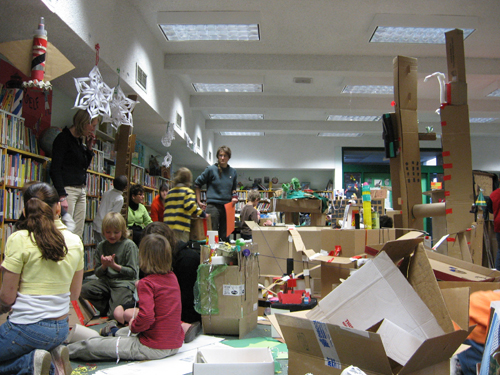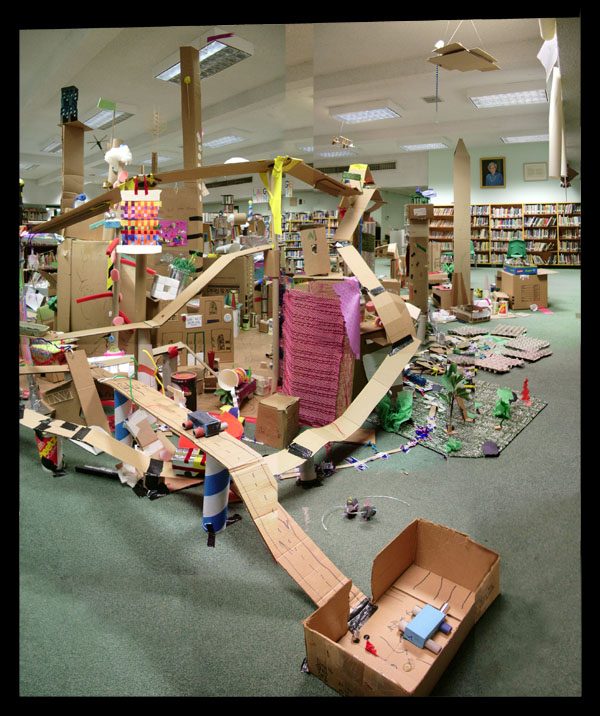Lego city harnesses the power of collective building
By Robin Amer

Lego city harnesses the power of collective building
By Robin Amer
Would-be architects and urban planners take note: this weekend you have the chance to join with fellow builders and toy-enthusiasts to construct a vast miniature city made entirely from Legos.
The event is sponsored by Illinois Institute of Technology’s Alumni Association and the school’s Mies van der Rohe Society, dedicated to honoring IIT’s most influential architecture school dean and campus planner.
But the gathering is not about replicating the slim, elegant glass and steel boxes that modernist legend Mies so favored, whether at 860-880 N. Lake Shore Drive or the Chicago Federal Center. And although some IIT students have employed Legos to craft scale models of other iconic Chicago buildings, Elisabeth Dunbar, the Mies van der Rohe Society’s director, said that “any time we’re bringing people to experience significant architectural spaces in a way that they’re not expecting, we’re fulfilling his legacy.”

Perhaps in the spirit of Koolhaas’ playful campus addition, participants are encouraged to channel their full creative energies. Photos from previous years reveal a slate of pint-sized buildings that many Chicagoans would find familiar: tiny Willis Tower replicas and vertical-lift bridges, for example. But one also sees fantastical pyramids, pagodas, spires and a big-footed monster building or two.
Dunbar’s crew of facilitators will have over 10,000 Legos on hand, stored in crates, she said, that are “taller than me.”
No doubt the plans for Saturday’s lego city build are fun — after all, this is same medium famously used to build everything from a miniature Death Star to tiny taxidermy.
But this kind of fantastical, collaborative building project has also has the potential to engage its participants in a kind of critical thinking about their role in the built environment that surrounds them everyday. It may even have the power to challenge visions of city planning as led by singular architectural and artistic geniuses like Mies van der Rohe and Rem Koolhaas.
Consider New Your City, a project orchestrated by the Providence, Rhode Island-based artist Ian Cozzens (who, for disclosure, is a close friend of mine).

“I was thinking about people in the city that weren’t in the ‘artist community,’” Cozzens said. “There was an authentic life in the city that wasn’t in architecture school.”
Cozzens was already admired for making highly-detailed silk screen prints based on elegant and carefully rendered architectural drawings of Providence’s historic buildings. But now he started looking for way to make his work more collaborative and more democratic. He began reading the work of Bernard Rudofsky, whose 1964 book Architecture Without Architects explored the richness and power of communally created works made by untrained builders.
“I definitely love the abdication of control and power,” Cozzens said.
As he considered what he’d learned at RISD, he thought, “Let’s turn these tools over to people who aren’t smarty pants architects.”
So Cozzens partnered with a local branch library in Providence, and carted in masses of cardboard boxes and tubes, construction paper, cotton balls, Elmer’s glue and whatever other crafting bric-a-brac he could find. Then he invited in local children to build a city, in miniature, in the normally staid and quiet space.

“We’d err on the side of anarchy as opposed to control,” Cozzens said.
But New Your’s citizens also faced a microcosm of the same kinds of land-use and property-rights issues adults might face in real city planning. For instance, one child would erect a house, and another would deface it with the scrawl of a marker, or rip it down and build a tiny cardboard highway in its place.
At this point, Cozzens said, the question raised by the project became: How do you build a city in a way that respects the visions and needs of all its inhabitants?
“Now the city needs guidelines,” he said. “Otherwise people are going to hurt each other, and each other’s feelings.”
New Your City was resurrected in the library again the following year, and Cozzens hoped the project gave the kids who participated a sense of agency.
“I spend more time thinking about floor layouts and the spacing of doors than other people do,” he said. “But that doesn’t mean that people don’t have ideas about how they want their space to be.”
Cozzens recalled one kid who was frustrated with the flimsiness of the cardboard and the short-lived nature of the project — after all, New Your City couldn’t stay in the library forever.
“This is OK,” the kid told Cozzens. “But we should be making it big. Real.”
“Yes,” Cozzens replied. “That’s the next thing.”
Build a Lego City takes place July 13 from 10 a.m. to 1 p.m. at the McCormick Tribune Campus Center on the IIT campus, 3201 S. State Street. Registration for the event is currently closed.
Robin Amer is a reporter and producer on WBEZ’s digital team. Follow her on Twitter @rsamer.


